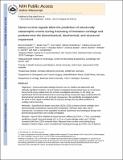| dc.contributor.author | Rolauffs, Bernd | |
| dc.contributor.author | Kurz, Bodo | |
| dc.contributor.author | Felka, Tino | |
| dc.contributor.author | Rothdiener, Miriam | |
| dc.contributor.author | Uynuk-Ool, Tatiana | |
| dc.contributor.author | Aurich, Matthias | |
| dc.contributor.author | Frank, Eliot | |
| dc.contributor.author | Bahrs, Christian | |
| dc.contributor.author | Badke, Andreas | |
| dc.contributor.author | Stöckle, Ulrich | |
| dc.contributor.author | Aicher, Wilhelm K. | |
| dc.contributor.author | Grodzinsky, Alan J. | |
| dc.date.accessioned | 2015-10-23T13:04:17Z | |
| dc.date.available | 2015-10-23T13:04:17Z | |
| dc.date.issued | 2013-06 | |
| dc.date.submitted | 2013-06 | |
| dc.identifier.issn | 10478477 | |
| dc.identifier.issn | 1095-8657 | |
| dc.identifier.uri | http://hdl.handle.net/1721.1/99422 | |
| dc.description.abstract | Objective
Trauma-associated cartilage fractures occur in children and adolescents with clinically significant incidence. Several studies investigated biomechanical injury by compressive forces but the injury-related stress has not been investigated extensively. In this study, we hypothesized that the biomechanical stress occurring during compressive injury predetermines the biomechanical, biochemical, and structural consequences. We specifically investigated whether the stress-vs-time signal correlated with the injurious damage and may allow prediction of cartilage matrix fracturing.
Methods
Superficial and deeper zones disks (SZDs, DZDs; immature bovine cartilage) were biomechanically characterized, injured (50% compression, 100%/s strain-rate), and re-characterized. Correlations of the quantified functional, biochemical and histological damage with biomechanical parameters were zonally investigated.
Results
Injured SZDs exhibited decreased dynamic stiffness (by 93.04 ± 1.72%), unresolvable equilibrium moduli, structural damage (2.0 ± 0.5 on a 5-point-damage-scale), and 1.78-fold increased sGAG loss. DZDs remained intact. Measured stress-vs-time-curves during injury displayed 4 distinct shapes, which correlated with histological damage (p < 0.001), loss of dynamic stiffness and sGAG (p < 0.05). Damage prediction in a blinded experiment using stress-vs-time grades was 100%-correct and sensitive to differentiate single/complex matrix disruptions. Correlations of the dissipated energy and maximum stress rise with the extent of biomechanical and biochemical damage reached significance when SZDs and DZDs were analyzed as zonal composites but not separately.
Conclusions
The biomechanical stress that occurs during compressive injury predetermines the biomechanical, biochemical, and structural consequences and, thus, the structural and functional damage during cartilage fracturing. A novel biomechanical method based on the interpretation of compressive yielding allows the accurate prediction of the extent of structural damage. | en_US |
| dc.description.sponsorship | National Institutes of Health (U.S.) (Grant R01-AR45779) | en_US |
| dc.description.sponsorship | Deutsche Forschungsgemeinschaft (Grant RO2511/1-1) | en_US |
| dc.description.sponsorship | Deutsche Forschungsgemeinschaft (Grant RO2511/2-1) | en_US |
| dc.description.sponsorship | Germany. Federal Ministry of Education and Research (Grant 01KQ0902B TP2) | en_US |
| dc.language.iso | en_US | |
| dc.publisher | Elsevier | en_US |
| dc.relation.isversionof | http://dx.doi.org/10.1016/j.jsb.2013.06.011 | en_US |
| dc.rights | Creative Commons Attribution | en_US |
| dc.rights.uri | http://creativecommons.org/licenses/by-nc-nd/4.0/ | en_US |
| dc.source | PMC | en_US |
| dc.title | Stress-vs-time signals allow the prediction of structurally catastrophic events during fracturing of immature cartilage and predetermine the biomechanical, biochemical, and structural impairment | en_US |
| dc.type | Article | en_US |
| dc.identifier.citation | Rolauffs, Bernd, Bodo Kurz, Tino Felka, Miriam Rothdiener, Tatiana Uynuk-Ool, Matthias Aurich, Eliot Frank, et al. “Stress-Vs-Time Signals Allow the Prediction of Structurally Catastrophic Events During Fracturing of Immature Cartilage and Predetermine the Biomechanical, Biochemical, and Structural Impairment.” Journal of Structural Biology 183, no. 3 (September 2013): 501–511. | en_US |
| dc.contributor.department | Massachusetts Institute of Technology. Center for Biomedical Engineering | en_US |
| dc.contributor.department | Massachusetts Institute of Technology. Department of Biological Engineering | en_US |
| dc.contributor.mitauthor | Rolauffs, Bernd | en_US |
| dc.contributor.mitauthor | Frank, Eliot | en_US |
| dc.contributor.mitauthor | Grodzinsky, Alan J. | en_US |
| dc.relation.journal | Journal of Structural Biology | en_US |
| dc.eprint.version | Author's final manuscript | en_US |
| dc.type.uri | http://purl.org/eprint/type/JournalArticle | en_US |
| eprint.status | http://purl.org/eprint/status/PeerReviewed | en_US |
| dspace.orderedauthors | Rolauffs, Bernd; Kurz, Bodo; Felka, Tino; Rothdiener, Miriam; Uynuk-Ool, Tatiana; Aurich, Matthias; Frank, Eliot; Bahrs, Christian; Badke, Andreas; Stöckle, Ulrich; Aicher, Wilhelm K.; Grodzinsky, Alan J. | en_US |
| dc.identifier.orcid | https://orcid.org/0000-0002-4942-3456 | |
| mit.license | PUBLISHER_CC | en_US |
| mit.metadata.status | Complete | |
